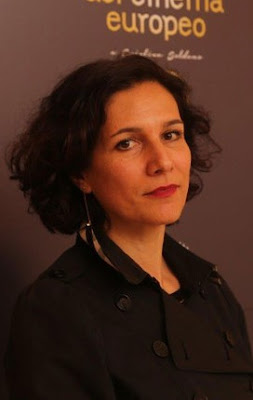Last year, as
TrustMovies recalls, the streaming behemoth
Netflix had but a single major contender in the Academy Awards competition:
Roma, which walked away with three awards (Foreign Language Film, Direction and Cinematography). This year the company has a quartet of major contenders up for the Oscars, with a good chance that all four will be nominated and probably two or three of the bunch winning in one or more categories. As all have been covered at this point by most critics, I'll do only a quick round-up here, though in one particular case, my feelings seem to be going against most other opinions.
I'll start with the film that will almost surely be seen the least of the four. Of course: It's animated and it's French.
I LOST MY BODY, however, is in many ways the most interesting and surprising of the bunch.
It is
so good that I can't imagine a nomination will escape it. As for the award, I also can't believe that a Disney steamroller like
Frozen II won't win the day. Yet this short (only 80 minutes, including rather lengthy end credits) little gem is chock full of real imagination rather than mere (though nicely done) special effects.
I Lost My Body tells three stories, two of which involve the character of Naoufel -- one as a little boy, the other as a young man. The third tale, the strangest and richest, gives us a hand severed from its body and trying every which way to find its owner and reconnect. Who owns the hand will not be hard to guess; the clues are certainly there. But how director/co-writer
Jérémy Clapin brings these tales to gorgeous, pulsating life is a wonder to behold.
The dialog is always smart, often charming, witty and even subtle, but the visuals are what most drive the film, changing everything from location to mood to color palette with such dexterity as to leave you consistently agape with wonder and pleasure. Streaming now on Netflix, this is one movie animation fans daren't miss.
Speaking of unmissable, top-notch performances from two terrific Welsh actors are equally worth viewing. You'll find these -- via
Anthony Hopkins and
Jonathan Pryce -- in
THE TWO POPES, a much-better-than-need-be movie directed with his usual unshowy skill at making disparate scenes build to an emotional whole by
Fernando Meirelles and written smartly and intelligently by
Anthony McCarten. Said to be based on true events, the film tackles the seemingly thorny relationship between the conservative past Pope Benedict (played by Mr. Hopkins, below, left) and new liberal Pope Francis (Mr. Pryce, below, right).
Oddly but workably, the movie gives us quite a parade of scenes involving Pope Francis' earlier life (in which he is played by Argentine actor
Juan Minujín, below), while leaving out just about everything we might learn about the departing Benedict. Fortunately, the film does not shy away from Francis' involvement with the military junta/dictatorship that left thousands dead and/or missing in Argentina, even if how much and how evil that involvement actually was is left for us to ponder.
The scenes between Hopkins and Pryce are filled with witty, often lip-smacking, sometimes sparkling dialog, and while the actors go to town with these, never does either over-do anything. What sheer pleasure is to be had from watching two pros at work with material this good! I don't think you have to be Catholic or even religious to appreciate this very enjoyable and -- in its own mild manner -- somewhat important film. You can find it streaming now on Netflix.
The title
MARRIAGE STORY may be a mite misleading.
Divorce Drama (with some choice comedy included) might be a better moniker. Either way,
Noah Baumbach's latest is very possibly his best (among a flock of films --
The Squid and the Whale through
The Meyerowitz Stories -- not one of which has been bad).
As writer/director, Baumbach has always explored relationships, and this film, I think, is his most insightful, not simply in the way it probes how relationships work (and don't) from the angle of both the man and the woman but in this case, how lawyers work and tend to finally own the terrain, leaving their clients pretty much bereft of each other and any leftover funds.
The movie also demonstrates how these relationships often never really die or end. Not when children are involved. Baumbach's stars are the ubiquitous, talented and versatile
Adam Driver (above, right) and
Scarlett Johansson (above, left), abetted by co-stars like
Laura Dern (below, as her attorney), and
Ray Liotta and
Alan Alda (both as his). The are all first-rate. Along the way, we're treated to plenty of drama and comedy, and even a couple of musical numbers, written by that master of modern relationships,
Stephen Sondheim, and performed very well, too!)
The build here is slow (but sure) and finally quite effective, leading to an ending that could hardly be more poignant or believable. Those of us who are divorced will surely empathize and ache. Those who have this yet to come should take note (and maybe notes) in preparation. Meanwhile,
Marriage Story, streaming now on Netflix, is one of the year's best films.
And now we come to what is, for me, the year's biggest over-hyped disappointment:
THE IRISHMAN, with a competent-if-somewhat-tiresome screenplay by
Steven Zaillian and directed at what, as the finale approaches, has seemed a snail's pace by
Martin Scorsese. Yes, we're on that Mafia train again (the director's favorite), this time with
Jimmy Hoffa aboard. (The 1992
Jack Nicholson/Danny DeVito/David Mamet movie was a much better and shorter version of some of these events.)
At a running time of three-and-one-half hours, the film is at least one hour too long for the content, not to mention style, it supposedly offers. And what are we to make of the huge critical acclaim for Mr. Scorsese's possibly final work? One major critic raves about the director's maturity in at last being able to cut away from a violent mob hit to show us a streetside flower shop -- as though directors had not been doing this very thing for years now. Please: The cult of Scorsese really needs to have its balloon popped, and soon -- before the director takes home his second undeserved Oscar (
The Departed still rankles as one of the lesser Best Pictures in recent memory -- and not a patch on its
Hong Kong original).
Star
Robert De Niro (above, center), who appears, as I recall, in every scene of the movie, is a good but not particularly versatile actor. And so it is once again. He takes the title character and makes him into a believable and quiet bore of a hitman. During the first couple of hours, the movie chugs along reasonably well, but as the final 90 minutes roll out, the seemingly endless and repetitive scenes between De Niro and
Al Pacino (above, to De Niro's right, as Hoffa), the former telling the latter,
You gotta stop
this, Jimmy!, and the latter telling the former,
They wouldn't dare
do anything to me
! (or words to that effect), you finally want to scream,
Enough already! But on they go, again and again.
Over the complete 209 minutes, not a single character grows or changes, even a bit. Granted this is the Mafia, so what do we expect? Still, it's our precious time that's a-wasting here.
Joe Pesci (above, left), forsaking the scenery-chewing for which we best remember him, proves very good at saying things without actually saying them, and Pacino shows us he can still chew with best of them. But to what avail? The soundtrack is full of music of the time, and the production design captures the look of the period just fine. Scorsese, thankfully, does not glamorize the Mafia, as just about all American movies (and TV/cable shows, including
The Sopranos), have done. But is there truly
anything interesting or remotely edifying left to say about any of this mob shit? On the basis of
The Irishman (now streaming on Netflix), I guess not.

















































